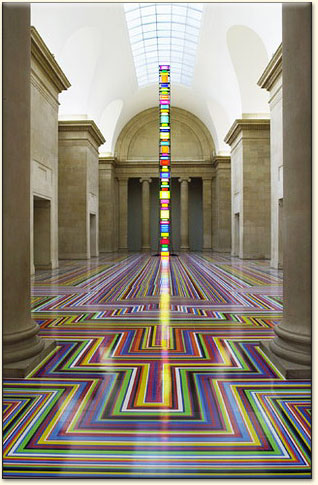Jim Lambie's Floor Installations

Touch Zobop, Jim Lambie, Duveen Galleries, Tate Britain, 2003.
Since 1999, the Glasgow-based artist Jim Lambie (1964) has used glossy tape in varying colors to build floor installations such as Touch Zobop (2003). The vinyl tape, an everyday material applied in continuous lines, has a capacity to transform the dynamics of space, changing a quiet gallery space into an energetic and emotional space of sensory pleasure. Lambie creates a rhythm that vibrates and pulsates, and even confuses and disorients the spectator. According to Lambie:
“For me something like Zobop, the floor piece, it is creating so many edges that they all dissolve. Is the room expanding or contracting? … Covering an object somehow evaporates the hard edge off the thing, and pulls you towards more of a dreamscape.”
Lambie has a musical background. Like music, his art fills its surroundings and transforms the environment. As Lambie says, “You put a record on and it’s like all the edges disappear. You’re in a psychological space. You don’t sit there thinking about the music, you’re listening to the music. You’re inside that space that the music’s making for you.”
Lambie’s art compares to Bridget Riley’s Op Art, in that it also uses contrasting colors and geometric patterns that create optical effects. However, unlike Riley’s work, Lambie’s works are site-specific and depend on existing gallery architecture. Therefore, Lambie’s work exists only as long as it is installed in art space: it cannot be reproduced in another space with a similar effect. Although Lambie does not share the highly theoretical framework of minimalist artists, both share an interest in direct art experience. As with Carl Andre’s minimalist walk-on floor pieces, Lambie’s spectator enters into the space of the art object.